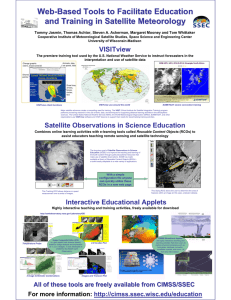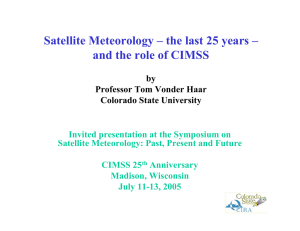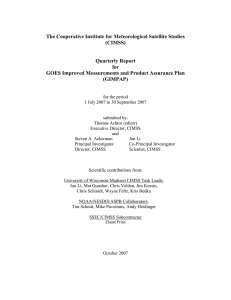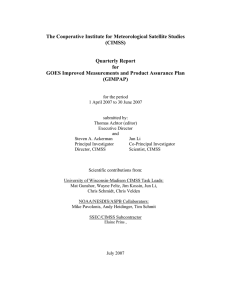The Cooperative Institute for Meteorological Satellite Studies (CIMSS) Quarterly Report
advertisement
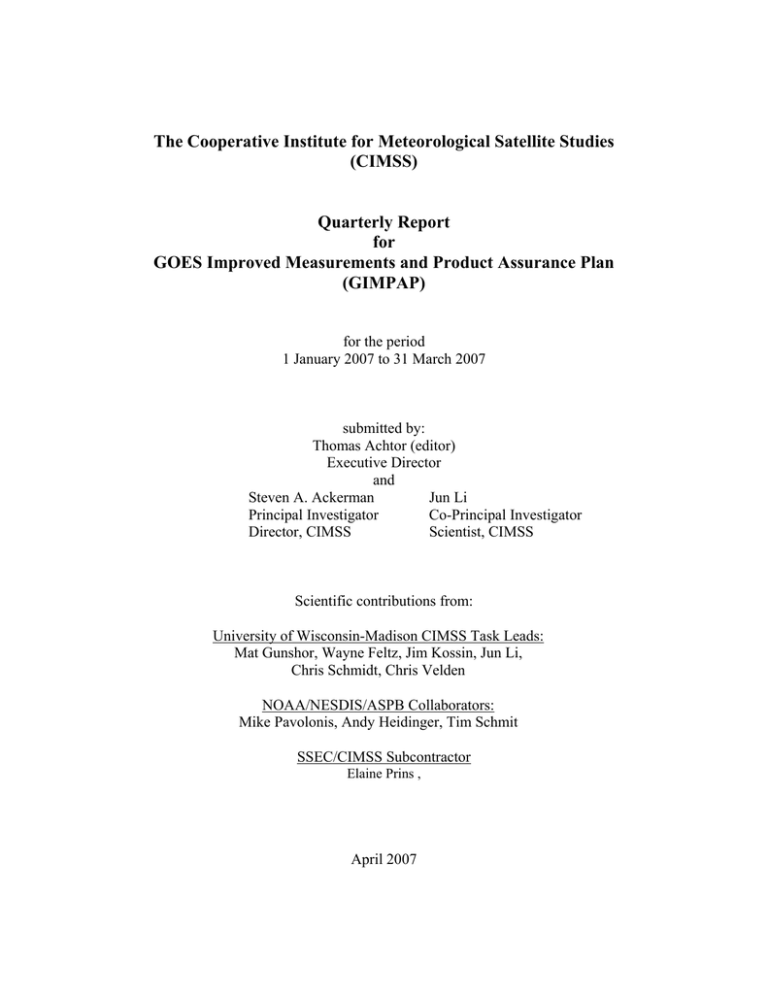
The Cooperative Institute for Meteorological Satellite Studies (CIMSS) Quarterly Report for GOES Improved Measurements and Product Assurance Plan (GIMPAP) for the period 1 January 2007 to 31 March 2007 submitted by: Thomas Achtor (editor) Executive Director and Steven A. Ackerman Jun Li Principal Investigator Co-Principal Investigator Director, CIMSS Scientist, CIMSS Scientific contributions from: University of Wisconsin-Madison CIMSS Task Leads: Mat Gunshor, Wayne Feltz, Jim Kossin, Jun Li, Chris Schmidt, Chris Velden NOAA/NESDIS/ASPB Collaborators: Mike Pavolonis, Andy Heidinger, Tim Schmit SSEC/CIMSS Subcontractor Elaine Prins , April 2007 Quarterly Report for GOES Improved Measurements and Product Assurance Plan (GIMPAP) 1 January 2007 to 31 March 2007 Table of Contents 1. 2. Single Field-of-View (SFOV) Sounding Retrieval Science ....................................... 3 Global Observing System Studies - Intercalibration .................................................. 7 2.1 2.2 3. 4. GOES Winds............................................................................................................... 9 GOES Tropical Cyclone Applications...................................................................... 10 4.1 4.2 5. Global Observing System Studies.................................................................................. 7 Intercalibration of GOES and POES.............................................................................. 8 SAL, ADT and Integrated Intensity Algorithms.......................................................... 10 GOES Imager Applications to Hurricane Intensity Change ........................................ 12 Biomass Burning Research ....................................................................................... 12 6. GOES Imager SATellite Convection AnalySis and Tracking (SATCAST) System Product Evaluation by NOAA/NESDIS Operations......................................................... 15 7. Cloud Products.......................................................................................................... 16 Quarterly Report for GOES Improved Measurements and Product Assurance Plan (GIMPAP) 1 January 2007 to 31 March 2007 1. Single Field-of-View (SFOV) Sounding Retrieval Science Lead Scientist: Jun Li Summary of GOES Sounder retrieval progress GOES Sounder SFOV (single field-of-view) ozone has been improved, we are working with Shobha Kondragunta to contact the NWS (National Weather Service) and EPA (Environmental Protection Agency) for an operational path. In addition, the algorithm has been modified for ozone retrieval using Spinning Enhanced Visible and Infra-Red Imager (SEVIRI) data. Following Dr. Jim Purdom’s advice at the GIMPAP review meeting in August 2006, we are collaborating and will continue to collaborate with EUMETSAT on ozone retrieval using geostationary satellite data. See section 1.1 for details. Following the GIMPAP TAC (Technical Advisory Committee) guidance, we have implemented the clustering technique to GOES Sounder radiance measurements. Initial results show that this technique is very useful in convective storm nowcasting using the GOES Sounder data. See section 1.2 for details. We continue to study the GOES Sounder temporal information (time continuity) in SFOV sounding retrieval, we have tested several approaches using previous time step information in the current time step sounding retrieval, and results still show neutral impact when compared with that using only current time step information. Time continuity studies will continue. See section 1.3 for details. 1.1. Continue collaboration between CIMSS and EUMETSAT on geostationary ozone improvement For collaboration, the improved GOES Sounder total column ozone (TCO) retrieval algorithm (Li et al. 2007, GRL) has been applied to SEVIRI data. The retrieved TCO has good agreement (R=0.92, RMSE=4% approximately) with that from OMI (Ozone Monitoring Instrument) onboard the EOS/Aura platform. Figure 1 shows the scatterplot between SEVIRI and OMI (left), the OMI ozone image (upper right), and the SEVIRI ozone image (lower right) under clear skies from 14 to 15 February 2006. OMI provides global ozone measurements once every day, while SEVIRI provides hemispheric ozone product every 15 minutes. We have sent Dr. Johannes Schmetz, Head of Meteorological Division at EUMETSAT, our SEVIRI ozone research results; they are very interested in the collaboration and are revisiting their ozone algorithms (communication with Dr. Schmetz. Figure 1. Scatterplot between SEVIRI and OMI (left), the OMI ozone image (upper right), and the SEVIRI ozone image (lower right) under clear skies from 14-15 February 2006. 1.2. Clustering technique for GOES Sounder radiances Following GIMPAP TAC (Technical Advisory Committee) guidance, we have implemented the clustering technique to GOES Sounder radiance measurements, initial results show that this technique is very useful in convective storm nowcasting using the GOES Sounder data. The hail storm of 13-14 April 2006 caused damage to many houses in the Madison, Wisconsin area. The storm produced very large hail (golf ball size). The GOES Sounder 11 µm image at 22 UTC on 13 April shows that a super cell is likely to have developed. The multispectral band classification (Li et al. 2003, JAM) shows that there are typical four classes (4, 5, 6, 10) of clear air mass surrounding the super cell (see Figure 2), two hours later (00 UTC on 14 April) the class 10 moves toward east while class 6 moves towards the north. The clear sky atmosphere is very unstable from 22 UTC to 00 UTC, and the super cell starts to develop. From 00 UTC on 13 April to 02 UTC on 14 April, the air mass continues to move (classes 6 and 10), and the super cell develops rapidly. The soundings observed by GOES Sounder before and during the convective storm are very useful for short range storm forecasts. Figure 2. Clear air mass classes from clustering (upper panels) and 11 µm brightness temperature images at 22 UTC on 13 April, 00 UTC and 02 UTC on 14 April 2006. 1.3. Application of time continuity in GOES SFOV sounding retrieval We continue to study the application of temporal information (time continuity) in GOES Sounder SFOV sounding retrieval. We have tested several approaches using previous time step information (e.g., retrieval or forecast information from previous time step) in the current time step sounding retrieval. The results still show neutral impact of time continuity when compared with that using only current time step information. Figure 3 shows the GOES Sounder regular SFOV total precipitable water (TPW) (black star, without time continuity), TPW retrieval with time continuity (red star) and the microwave radiometer measured TPW (blue) over the four ARM (Atmospheric Radiation Measurement) sites in Oklahoma on 13 April 2006. For time continuity in this case, retrieval from previous time step was used as the first guess in the current time step retrieval. Neutral impact of time continuity is seen from this case. Figure 3. The GOES Sounder regular SFOV TPW (black star, without time continuity), TPW retrieval with time continuity (red star) and the microwave radiometer measured TPW over four ARM sites in Oklahoma on 13 April 2006. The impact of GOES Sounder time continuity techniques on sounding retrieval needs be further evaluated. We think that optimal use of time continuity in GOES Sounder SFOV processing remains a challenge. For future GOES imager, for example, ABI (Advanced Baseline Imager), time continuity is expected to show positive impact due to its very high temporal resolution (better than 15 minutes). Recent presentations and publications related to this report (1) Jin, Xin, Jun Li, Christopher C. Schmidt, Timothy J. Schmit, and Jinlong Li, 2007: Retrieval of Total Column Ozone from Imagers Onboard Geostationary Satellites, IEEE Transactions on Geosciences and Remote Sensing (conditionally accepted). (2) Li, Jinlong, Jun Li, Christopher Schmidt, James Nelson III, and Timothy Schmit, 2007: High Temporal Resolution GOES Sounder Single Field of View Ozone Improvements, Geophysical Research Letters, 34, L01804, doi:10.1029/2006GL028172. (3) Li, Jun, W. P. Menzel, Z. Li, G. Wade, T. J. Schmit, Jinlong Li, R. Aune, A. J. Schreiner, C. C. Schmidt ,I. Genkova, and J. P. Nelson III, 2006: Development and Applications of the GOES Sounder Products, presented at the 36th COSPAR Scientific Assembly, July 16 - 23, 2006 in Beijing (trip was supported by another project). (4) Li, Zhenglong, Jun Li, W. P. Menzel and T. J. Schmit, 2006: GOES Sounder single FOV soundings, presented at NOAA/NESDIS Cooperative Research Program (CoRP) Third Annual Science Symposium on NPOESS, GOES-R and Beyond: New Observations and Applications to Benefit Society, 15 - 16 August 2006, Fort Collins, CO (trip was supported by NESDIS CoRP). (5) Schmidt, C. C. And J. Li, 2006: Estimating ozone with the GOES Sounder and comparable sensors, presented at SPIE Remote Sensing of Aerosol and Chemical Gases, Model Simulation/Assimilation, and Applications to Air Quality, Proceeding of SPIE 6299, 13 - 17 August 2006, San Diego, CA. 2. Global Observing System Studies - Intercalibration Lead Scientists: Mat Gunshor, Tim Schmit 2.1 Global Observing System Studies Background The primary purpose of this intercalibration project is to compare select infrared channels on geostationary instruments (GOES, Meteosat, etc) with those obtained from the polarorbiting instruments (NOAA AVHRR and HIRS, EOS AIRS). This project covers research into new/improved methods, testing new satellite instruments, diagnosing problems on existing instruments, and the analysis and presentation of results. Summary Scientists from CIMSS attended the Global Space-Based Inter-Calibration System (GSICS) 1st meeting of the GSICS Research Working Group (GRWG-I) on 22-23 January 2007 in the NOAA Science Center in Camp Springs, Maryland. Summaries were presented of the Intercalibration work done at CIMSS over the past decade covering a wide-range of satellite to satellite intercalibration, aircraft-based validation, and groundbased validation of satellite instrument calibration. Recommendations were made to the international GSICS council on how to proceed with coordinated efforts to intercalibrate the world's geostationary imagers using polar-orbiting high spectral resolution instruments such as the Atmospheric InfraRed Sounder (AIRS) onboard Aqua (United States) and eventually the Infrared Atmospheric Sounding Interferometer (IASI) onboard MetOp-A (Europe). The operational geostationary imager currently operating at 0 degrees longitude is EUropean organization for the exploitation of METeorological SATellites (EUMETSAT)'s METeorological SATellite (METEOSAT)-8, which will be replaced by METEOSAT-9 on April 11, 2007. Due to a brief malfunction in METEOSAT-8, METEOSAT-9 was the operational satellite from 23 September to 10 October of 2006. Data were collected during this time for comparison to the polar-orbiting, high spectral resolution, Atmospheric InfraRed Sounder (AIRS). Preliminary results, based on a relatively small sample size, showed that METEOSAT-9 compared well to AIRS and to METEOSAT-8 (vicariously through AIRS), which bodes well for the generation of products and the use of those data in numerical weather prediction (NWP) applications. These results were presented electronically in March 2007 as a slide show with the international Global Space-Based Inter-Calibration System (GSICS) committee. During the Geostationary Operational Environmental Satellite (GOES)-13 post-science test analysis, comparisons with high-spectral Atmospheric InfraRed Sounder (AIRS) data and with broad-band High-resolution Infrared Radiation Sounder (HIRS) data on National Oceanic and Atmospheric Administration (NOAA)-15 and NOAA-16 show that there appears to be a cold bias on the order of -2 K in the GOES-13 Imager band 6 (13.3 micrometer). This may be mitigated via the use of a bias correction. Preliminary work was also done regarding the shifting of the band Spectral Response Function (SRF) to reduce the apparent bias. A memo was written on this subject and begun to circulate among interested parties in March 2007. Shifting the SRF by -4.7 cm-1 reduced the mean difference in these 19 cases from -2.4 K to effectively 0 K. Table 1: Comparison of GOES-13 Imager to Atmospheric InfraRed Sounder (AIRS). The sample size is 19. Standard Deviation of Imager Band Bias (K) Differences (K) 0.2 0.6 2 (3.9 μm) -0.4 0.3 3 (6.5 μm) -0.1 0.4 4 (10.7 μm) 0.6 -2.4 6 (13.3 μm) 2.2 Intercalibration of GOES and POES Background Calibration and instrument intercomparison are the main methods by which individual instruments can be validated against one another between the geostationary and polar orbiting platforms. Routine automated intercalibration provides information on how operational geostationary environmental satellites around the globe compare radiometrically. CIMSS has been intercalibrating satellite instruments routinely since 1999 and the methodology is documented in the research journal literature (Gunshor et al. 2004). Research into new/improved methods, testing new satellite instruments, diagnosing problems on existing instruments, and the analysis and presentation of results have been covered under the broader CIMSS GIMPAP proposal topics. This Intercalibration task covers the routine production of results, the routine posting of results on the World Wide Web, software maintenance, and the implementation of knowledge gained from the research done in section 2.1 of this proposal (Global Observing System Studies). This Intercalibration task was previously funded under the NOAA G-PSDI program, but funding this year was moved to the GIMPAP project. The primary purpose of this Intercalibration project is to compare the infrared window, water vapor, and 13.3 micrometer CO2-absorption band channels on geostationary instruments (e.g. GOES, Meteosat) by using the same spectral bands on polar-orbiting instruments (e.g. NOAA AVHRR and HIRS). This task is accomplished by making multiple comparisons at the geostationary sub-satellite points and finding an average brightness temperature difference between the geostationary and the polar orbiter spectral bands. Comparison of satellite radiances leading to an improved knowledge of calibration is important for various global applications of satellite data where data from more than one instrument are combined for a single purpose. The CGMS (Coordination Group for Meteorological Satellites) has requested satellite operators to regularly perform satellite intercalibration. The World Meteorological Organization (WMO) has initiated a global intercalibration project called the Global Space-based Intercalibration System (GSICS) with NOAA/NESDIS as a lead agency. This intercalibration work directly supports this international collaboration among satellite providers. Summary There have been several changes in the international line-up of geostationary imagers that were addressed this quarter. METEOSAT-7 replaced METEOSAT-5 over the Indian Ocean at 65 degrees east longitude. GOES-10 has been moved to 60 degrees west longitude for service over South America. These satellite changes require making changes to the code that collects and processes data as well as to the Intercalibration web page. Both GOES-10 and METEOSAT-7 have been added to the active section of the Intercalibration web page and are now a part of the routine schedule. METEOSAT-5 has been moved to the archive section of the web page. 3. GOES Winds Lead Scientist: Chris Velden Accomplishments over the past 3-months include (but are not limited to): 1) We have completed the study of using GOES image pairs for cloud height assignments. Both stereo and shadow techniques were tested in a few selected case studies. Matching software was written and tested, and the algorithm’s performance is being evaluated. The results of this work are being finalized and will be reported on in the next Quarterly Report. 2) The data assimilation community continues to struggle with effective integration of satellite-derived winds into current variational analysis schemes. As a result, observing system experiments show the winds offer only a modest positive impact on NWP forecasts. During this quarter we continued to test a new regression-based quality indicator referred to as the “Expected Error” (EE). This index is designed to attach to every vector record and indicate the confidence in the form of an expected vector RMSE. Our analyses suggest the EE is a better indicator of quality than the existing operational QI (Quality Indicator). We are in the process of examining this new EE for data assimilation screening properties, and eventually for observation weighting in NWP applications. 3) We are taking a fresh look at GOES winds height assignments. Instead of treating the winds as vectors representing discrete levels, our analysis is focusing on tropospheric layers. Using collocated rawinsonde and wind profilers, GOES winds are matched to the vertical wind profiles and a “layer of best fit” (minimization of RMSE) is identified. Preliminary results of this analysis are finding the layer matches are superior to the levels of best fit. The matches are being broken down by wind type and height assignment method, to better characterize the height assignment traits by layers. We expect a journal publication of the final results to be completed by the next reporting period. 4. GOES Tropical Cyclone Applications Lead Scientists: Chris Velden (4.1), Jim Kossin (4.2) 4.1 SAL, ADT and Integrated Intensity Algorithms Accomplishments over the past 3 months include (but are not limited to): 1) The CIMSS Tropical Cyclones (TC) group continues to develop diagnostic fields derived from GOES winds analyses for applications to TCs. These products include analyses of vertical wind shear, vorticity, upper-level divergence, vertical wind shear tendency, steering currents, and surface adjusted cloud-drift winds. All of these products are featured on the CIMSS Tropical Cyclones web site (http://cimss.ssec.wisc.edu/tropic/tropic.html), which has become an extremely popular “public outreach” site for the general public, researchers, and forecasters during TC events. We continue to maintain and upgrade the GOES-derived products and develop new ones often based on community/user feedback. During this reporting period we have begun working on a new innovated page site that will allow increased user interaction and visualization capabilities. Also, GOES datasets and products are continuously requested and provided to the user community for expanding scientific research on TCs. Therefore, we are scoping the development of an online GOES TC product archive. 2) We continue to conduct basic research and upgrade the Advanced Dvorak Technique (ADT) algorithm, which is now used by several NOAA and DoD tropical cyclone analysis centers. The algorithm upgrades have focused on a statistical evaluation of the performance in specific cases to better understand the behavior and areas of weakness. We are working to ensure (through G-PSDI funding) that the latest versions are available to NESDIS/SAB and NOAA/TPC and CPHC. More information can be found at: http://cimss.ssec.wisc.edu/tropic/adt/ 3) The CIMSS TC group continues to explore an integrated approach to satellite-based TC intensity estimation through a weighted consensus of satellite-based ADT, and AMSU methods derived at CIMSS and at CIRA. The approach (SATCON) has first identified the strengths and weaknesses of each individual method, which is then used to assign weights towards a consensus algorithm designed to better estimate TC intensity. A statistical analysis reveals the approach is superior to the independent algorithms evaluated alone (see Figure 4). This new approach will be tested in near real time during the 2007 hurricane season. For more information, see: http://cimss.ssec.wisc.edu/tropic/satcon/satcon.html Figure 4. Statistical analysis of SATCON performance of TC maximum sustained winds (MSW) for a sample of 274 matches with ground truth. 4) We continue the application of the geo satellite-based Saharan Air Layer (SAL) detection technique. Tropical rawinsondes and special aircraft dropwindsondes were collected during this past summer season and are being used to help calibrate and validate the SAL product. We will continue to build SAL cases via the satellite-derived product to study the association between TC intensity behavior with SAL interaction. Publications: Olander, T., and C. Velden, 2007: The Advanced Dvorak Technique (ADT): Continued development of an objective scheme to estimate tropical cyclone intensity using geostationary satellite IR information. Accepted in Wea. and Fore., to appear in April 2007 issue. Olander, T. and C. Velden, 2007: Update on the Advanced Dvorak Technique. Proceedings Tropical Cyclone Conference, Pearl Harbor, HI, Herndon, D. and C. Velden, 2007: SATCON: A new TC intensity estimation algorithm. Proceedings Tropical Cyclone Conference, Pearl Harbor, Hi. Herndon, D. and C. Velden, 2007: CIMSS Satellite Consensus (SATCON) Tropical Cyclone intensity estimation algorithm. Proceedings Interdepartmental Hurricane Conference, New Orleans, LA. 4.2 GOES Imager Applications to Hurricane Intensity Change Project Description: The goal of this research is to extract more information from GOES IR imagery that is related to hurricane intensity change, and apply this information to increasing intensity forecast skill through modification of the SHIPS model. Previous work has demonstrated that information gleaned from GOES IR imagery about the state of the hurricane innercore can also be related to intensity change. This was shown by the addition of GOES IR-based predictors to the existing environment-based predictor suite of SHIPS, which increased skill. The GOES data in these previous studies comprised imagery only back to 1995. Our first goal was to extend this dataset back in time. Accomplishments in the last three months Utilizing a new dataset constructed by lead scientist Kossin and colleagues at the NOAA National Climatic Data Center (NCDC), we have significantly extended the record of SHIPS predictors. This required: 1) Reprocessing of all GOES imagery during the period 1983–2005. 2) Constructing algorithms to analyze the data and extract the required SHIPS predictors. 3) Forming a new dataset for inclusion and testing in the SHIPS model. 4) Transferring the data and documentation to collaborators in the NOAA/NESDIS RAMM-B Team at CIRA/CSU (DeMaria and Knaff). 5. Biomass Burning Research Lead Scientists: Elaine Prins, Chris Schmidt The UW-Madison CIMSS burning team proposed four major tasks for 2007. CIMSS proposed to continue the GOES WF_ABBA trend analysis throughout the western hemisphere to assess changes in biomass burning and collaborate with the user community in environmental applications of the WF_ABBA data base. These collaborations include ongoing activities with the atmospheric modeling community to assimilate geostationary WF_ABBA fire products into aerosol/trace gas transport models. A new effort in collaboration with Dr. R. Rabin (NOAA/NSSL) and Dr. P. Bothwell (NOAA/NWS, Storm Prediction Center) focuses on applications of Rapid Scan GOES fire products for early detection of wildfires and agricultural burning and diurnal monitoring of fire variability. Finally, CIMSS proposed to continue to work with GTOS GOFC/GOLD, CGMS, and GEOSS to foster the development and implementation of a global geostationary fire monitoring network with international involvement. Accomplishments: Although efforts during the first quarter of 2007 were limited due to lack of funds, the UW-Madison CIMSS biomass burning team focused on updating the 7-year fire trend analysis for the Western Hemisphere (2000 – 2006) and identifying case studies for the rapid scan early warning fire detection analysis. The multi-year GOES WF_ABBA fire data set provides new insight into how fire patterns have changed in the Western Hemisphere over the past 7 years. Figure 5 provides a glimpse into variations in fire activity from 2000 to 2006. Fire pixels that were only detected in 2000 are shown in yellow, while fire pixels detected during 2006 are shown in red. Nothing is plotted for fire pixel locations that were observed in both years. There are regions where enhanced burning was observed in 2000 or in 2006, but the general patterns indicate a mixture of red and yellow. The most striking difference is along the arc of deforestation, where there is new burning (in red) along the northern edge of the arc of deforestation and along the perimeter of previous fire activity in Acre and clearly shows expansion of fire activity into the Amazon. Figure 5. GOES-8/-12 WF_ABBA filtered fire pixel difference composite for the Western Hemisphere. The yellow markers indicate fires that were only detected during the time period January 1 – December 31, 2000. The red markers indicate fire pixels that were only identified during the time period January 1 through December 31, 2006. In collaboration with Dr. R. Rabin (NOAA/NSSL) CIMSS has identified 3 case studies for analysis of rapid scan applications in early detection of wildfires and diurnal monitoring. These case studies include the Westside Fire in southern California in December 2006, the East Amarillo Complex Fire in March 2006, and the Hayman and Rodeo Chediski Fires in June 2002. 6. GOES Imager SATellite Convection AnalySis and Tracking (SATCAST) System Product Evaluation by NOAA/NESDIS Operations Lead Scientists: Wayne Feltz, Kris Bedka Background CIMSS, in collaboration with the University of Alabama in Huntsville, currently produces a set of GOES-12 Imager satellite-derived products for diagnosing and nowcasting thunderstorm development, evolution, and motion. These products have been under development for four years under the NASA-supported Advanced Satellite Aviation-weather Products initiative for use in aviation safety applications (Mecikalski et al., 2006). CIMSS is currently providing these products to several groups, including the NOAA/NESDIS Satellite Application Branch (SAB) precipitation desk, in near real-time. The goal of this collaboration is to improve upon existing SAB satellite-derived guidance and precipitation forecasts. CIMSS convective weather products can identify rapidly developing convective storms, which should be monitored for heavy rainfall and flash flooding potential. SAB precipitation estimates are provided directly to National Weather Service Forecast Offices and Regional Forecast Centers and contribute to forecasts disseminated to the general public. The use of geostationary satellite imagery provides a clear advantage over operational NWP model guidance for short-term convective weather forecasting, as satellites observe the true state and evolution of a convective event at high temporal/spatial resolution, whereas NWP models often incorrectly simulate the timing and location of convective storm development. Satellite-derived products also have an advantage over WSR-88D radar products in that convective storm initiation is observed in satellite imagery before precipitation echoes are detectable by radar, providing valuable lead time for operational forecasters. Accomplishments for past quarter 1) We are collaborating with NOAA/SAB analysts in the optimal display, interpretation, and use of CIMSS satellite-derived convection diagnostic and nowcasting products. The Satellite Applications Branch will evaluate CI algorithm in spring of 2007. We have been working with Jay Hanna at NOAA/SAB. They have been running SATCast in a test mode and are able to reallocate the domain location and view results using McIDAS. Coordination the with NOAA NESDIS SAB will continue through the 2007 convective season 2) VISITview teletraining materials were developed that will help convey algorithm methodology for nowcasting interpretation. A training PowerPoint has been constructed and provided to interested uses, including the NOAA NESDIS SAB team. 3) The software has been optimized to operate on larger real-time domains. The CI domain will operate in two modes. First over Storm Prediction Center (SPC) convective risk domains and second over the upper Midwest in support of local forecast offices. SATCast is now operating over AWIPS Upper Midwest “States” domain. Results are being evaluated locally at CIMSS prior to distribution to local NWS office. Software optimization will occur Summer 2007. 4) We are working with local NWS offices (Sullivan, Green Bay, and La Crosse) to acquire user feedback and improve upon products where necessary. The SATCast mesoscale winds and convective initiation work was presented to forecasters at the Sullivan (Milwaukee) and La Crosse NWS offices. They have expressed strong interest in receiving mesoscale wind fields via AWIPS. Work is progressing. The mesoscale winds web site: http://cimss.ssec.wisc.edu/~jordang/awips-goes/meso/ . 5) We are coordinating with scientists at NSSL and CIRA on CIMSS aviation activities. A seminar at CIRA will be conducted in Fall or Winter 2007. 7. Cloud Products Lead Scientists: Andy Heidinger, Mike Pavolonis Brief Description of work proposed With the advent of the GOES-R Algorithm Working Groups, NOAA has begun to develop consensus prototype algorithms for GOES-R. Particularly, the cloud application team has developed a prototype system for testing cloud algorithms applied to geostationary imager data (GEOCAT). GEOCAT can process geostationary imager data from GOES, MSG/SEVIRI and MTSAT. Beyond the cloud height and effective cloud amount product from the GOES-12 imagers and the cloud mask from Clear-sky Brightness Temperature (CSBT), NOAA makes no other operational cloud products from the GOES imager. Most of the proposed GOES-R cloud products can in fact be produced from the current GOES imagers albeit with reduced accuracy. We propose therefore to implement GEOCAT applied to the GOES imager data in real-time at CIMSS and make cloud products available to all interested users for evaluation and comment. Summary of Results for Past Quarter We have not initiated work on this project. All of our efforts this quarter are on developing GEOCAT and imbedding the cloud algorithms into it. This work has been done under the GOES-R AWG project. GEOCAT is now fully functional as GOES processing system and we have demonstrated its robustness by running one month of MSG data through it and generating Level-1 files. Our next goal is generate cloud mask and cloud type Level-2 files. Figure 6 shows an example MSG image processed using the current GOES-R AWG cloud mask. Where there was no cloud detected, the surface temperature is shown. We expect by the third quarter of FY2007 to conduct the real-time implementation of GEOCAT proposed in this GIMPAP project. Figure 6 Example of the current GOES-R AWG cloud mask applied to SEVIRI. Image on left is the 0.65 micron reflectance and image on the right is the cloud mask overlaid on top of a surface temperature field.
